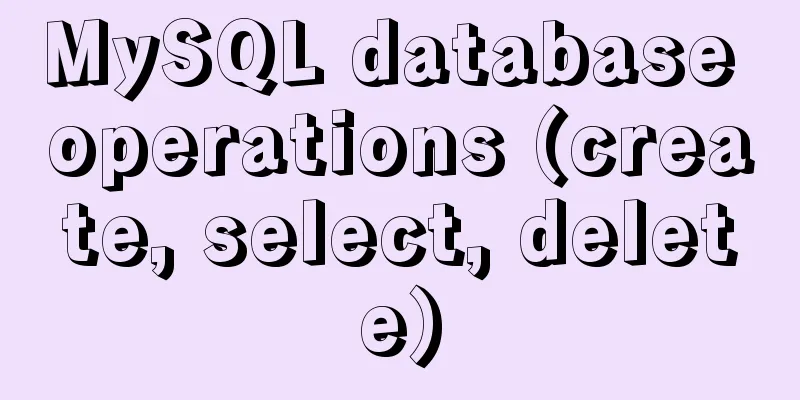MySQL database operations (create, select, delete)

|
MySQL Create Database After logging into the MySQL service, we can use the create command to create a database. The syntax is as follows:
The following command simply demonstrates the process of creating a database named RUNOOB: [root@host]# mysql -u root -p Enter password:****** # Log in to the terminal mysql> create DATABASE RUNOOB; Create a database using mysqladmin As a normal user, you may need specific permissions to create or delete MySQL databases. So we log in as the root user here. The root user has the highest permissions and can use the mysql mysqladmin command to create a database. The following command simply demonstrates the process of creating a database named RUNOOB: [root@host]# mysqladmin -u root -p create RUNOOB Enter password:****** After the above command is executed successfully, the MySQL database RUNOOB will be created. Creating a database using PHP script PHP uses the mysqli_query function to create or delete a MySQL database. This function takes two parameters and returns TRUE if the execution is successful, otherwise it returns FALSE. grammar
Examples The following example demonstrates how to create a database using PHP:
<?php
$dbhost = 'localhost'; // mysql server host address$dbuser = 'root'; // mysql username$dbpass = '123456'; // mysql username and password$conn = mysqli_connect($dbhost, $dbuser, $dbpass);
if(!$conn)
{
die('Connection error: ' . mysqli_error($conn));
}
echo 'Connection successful<br />';
$sql = 'CREATE DATABASE RUNOOB';
$retval = mysqli_query($conn,$sql);
if(!$retval )
{
die('Failed to create database: ' . mysqli_error($conn));
}
echo "Database RUNOOB created successfully\n";
mysqli_close($conn);
?>After successful execution, the following results are returned:
If the database already exists, after execution, the following results are returned:
MySQL Select Database After you connect to the MySQL database, there may be multiple databases that you can operate, so you need to select the database you want to operate. Select MySQL database from the command prompt window Selecting a specific database is easy from the mysql> prompt. You can use SQL commands to select a specific database. Examples The following example selects the database RUNOOB: [root@host]# mysql -u root -p Enter password:****** mysql> use RUNOOB; Database changed mysql> After executing the above command, you have successfully selected the RUNOOB database. All subsequent operations will be performed in the RUNOOB database. Note: All database names, table names, and table fields are case sensitive. So you need to enter the correct name when using SQL commands. Select MySQL database using PHP script PHP provides the function mysqli_select_db to select a database. The function returns TRUE if the execution is successful, otherwise it returns FALSE. grammar
Examples The following example shows how to use the mysqli_select_db function to select a database:
<?php
$dbhost = 'localhost'; // mysql server host address$dbuser = 'root'; // mysql username$dbpass = '123456'; // mysql username and password$conn = mysqli_connect($dbhost, $dbuser, $dbpass);
if(!$conn)
{
die('Connection failed: ' . mysqli_error($conn));
}
echo 'Connection successful';
mysqli_select_db($conn, 'RUNOOB' );
mysqli_close($conn);
?>MySQL delete database Log in to the MySQL server as a normal user. You may need specific permissions to create or delete a MySQL database, so we use the root user to log in here. The root user has the highest permissions. When deleting a database, you must be very careful because all data will disappear after executing the deletion command. The drop command deletes the database drop command format:
For example, to delete a database named RUNOOB: mysql> drop database RUNOOB; Deleting a database using mysqladmin You can also use the mysql mysqladmin command to execute the delete command in the terminal. The following example deletes the database RUNOOB (the database has been created in the previous chapter): [root@host]# mysqladmin -u root -p drop RUNOOB Enter password:****** After executing the above command to delete the database, a prompt box will appear to confirm whether to delete the database:
Deleting a database using a PHP script PHP uses the mysqli_query function to create or delete a MySQL database. This function takes two parameters and returns TRUE if the execution is successful, otherwise it returns FALSE. grammar
Examples The following example demonstrates using the PHP mysqli_query function to delete a database:
<?php
$dbhost = 'localhost'; // mysql server host address$dbuser = 'root'; // mysql username$dbpass = '123456'; // mysql username and password$conn = mysqli_connect($dbhost, $dbuser, $dbpass);
if(!$conn)
{
die('Connection failed: ' . mysqli_error($conn));
}
echo 'Connection successful<br />';
$sql = 'DROP DATABASE RUNOOB';
$retval = mysqli_query( $conn, $sql );
if(!$retval )
{
die('Failed to delete database: ' . mysqli_error($conn));
}
echo "Database RUNOOB deleted successfully\n";
mysqli_close($conn);
?>After successful execution, the results are:
Note: When using PHP script to delete a database, there will be no confirmation message to confirm whether to delete. The specified database will be deleted directly, so you must be particularly careful when deleting the database. The above is the details of MySQL database operations (create, select, delete). For more information about MySQL database operations, please pay attention to other related articles on 123WORDPRESS.COM! You may also be interested in:
|
<<: Solution to the problem that the Vue page image does not display
>>: Detailed explanation of Vue parent-child component value transfer and one-way data flow issues
Recommend
MySQL commonly used SQL and commands from entry to deleting database and running away
Table of contents Start and stop Database related...
HTTPS Principles Explained
As the cost of building HTTPS websites decreases,...
What to do if you forget the initial password of MySQL on MAC
The method to solve the problem of forgetting the...
9 Tips for MySQL Database Optimization
Table of contents 1. Choose the most appropriate ...
Detailed explanation of Vue's monitoring properties
Table of contents Vue monitor properties What is ...
Use momentJs to make a countdown component (example code)
Today I'd like to introduce a countdown made ...
Solve the problem of insufficient docker disk space
After the server where Docker is located has been...
An example of using a MySQL statement to find out the number of bytes occupied by various integers and their maximum and minimum values
Directly code: select 'bigint unsigned' a...
Mysql 5.6.37 winx64 installation dual version mysql notes
If MySQL version 5.0 already exists on the machin...
How to install and use Cockpit on CentOS 8/RHEL 8
Cockpit is a web-based server management tool ava...
2 reasons why html-css tag style setting does not work
1 CSS style without semicolon ";" 2 Tags...
Web2.0: Causes and Solutions of Information Overload
<br />Information duplication, information o...
Distributed monitoring system Zabbix uses SNMP and JMX channels to collect data
In the previous article, we learned about the pas...
HTML+css to create a simple progress bar
1. HTML code Copy code The code is as follows: Ex...
Perfect Solution for No rc.local File in Linux
Newer Linux distributions no longer have the rc.l...












